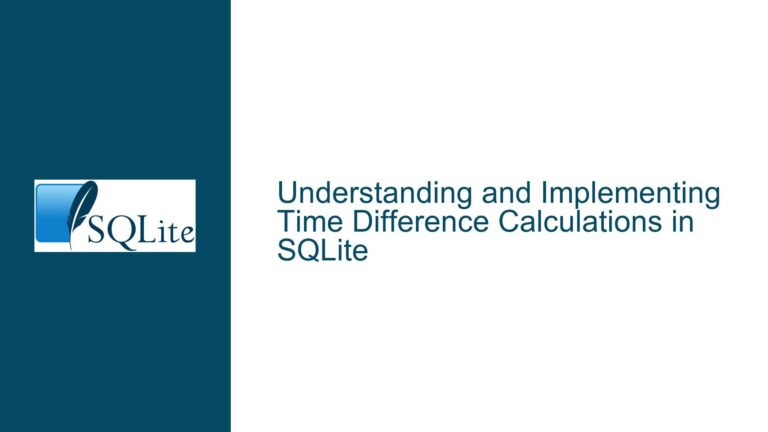Converting Semicolon-Separated Strings into Columns in SQLite
Understanding the Problem: Splitting Strings into Columns in SQLite
The core issue revolves around the need to split a semicolon-separated string into individual columns in SQLite. This is a common requirement when dealing with data that is stored in a delimited format, such as CSV files or logs, and needs to be parsed into a more structured format for querying and analysis. Unlike some other databases like Oracle, which provide built-in functions like regexp_substr for such tasks, SQLite does not natively support advanced string manipulation functions for splitting strings into columns. This limitation necessitates creative solutions using SQLite’s available features, such as Common Table Expressions (CTEs), JSON functions, or external extensions.
The challenge is further compounded by the requirement to split the string into columns rather than rows. Most SQL-based solutions, including those in SQLite, inherently split strings into rows due to the nature of relational databases. However, the goal here is to transform a single string into multiple columns, which requires a different approach. This issue is particularly relevant for users who are migrating from databases like Oracle, where such functionality is readily available, to SQLite, which has a more limited feature set for string manipulation.
Exploring the Limitations and Possible Causes
The primary cause of this issue is SQLite’s lack of built-in functions for advanced string splitting and manipulation. While SQLite is a powerful and lightweight database, it is designed to be minimalistic, which means it does not include many of the specialized functions found in larger databases like Oracle or PostgreSQL. For example, Oracle’s regexp_substr function allows users to extract specific substrings based on regular expressions, making it easy to split a string into columns. SQLite, on the other hand, does not have a native equivalent for this function.
Another contributing factor is the relational nature of SQL databases. In SQL, the result of a query is typically a set of rows, each containing a fixed number of columns. This makes it inherently difficult to dynamically generate columns based on the content of a string. While it is possible to split a string into rows using recursive CTEs or JSON functions, transforming it into columns requires a more complex approach, often involving multiple steps or external tools.
Additionally, the issue is exacerbated by the need for compatibility with existing tools and workflows. Many users rely on specific SQLite extensions or libraries, such as the json1 module or third-party extensions like sqlean, to extend SQLite’s functionality. However, these extensions may not always be available or compatible with the user’s environment, leading to further complications.
Detailed Solutions and Fixes for Splitting Strings into Columns
Using Recursive Common Table Expressions (CTEs)
One of the most powerful features of SQLite for handling complex string manipulation tasks is the use of recursive Common Table Expressions (CTEs). A recursive CTE allows you to iteratively process a string and split it into its constituent parts. While this approach typically results in rows, it can be adapted to generate columns by leveraging SQLite’s CASE statements and aggregation functions.
Here’s an example of how to use a recursive CTE to split a semicolon-separated string into columns:
WITH RECURSIVE split_string AS (
SELECT
substr(str, 1, instr(str || ';', ';') - 1) AS part,
substr(str, instr(str || ';', ';') + 1) AS remainder,
1 AS level
FROM t
UNION ALL
SELECT
substr(remainder, 1, instr(remainder || ';', ';') - 1),
substr(remainder, instr(remainder || ';', ';') + 1),
level + 1
FROM split_string
WHERE remainder != ''
)
SELECT
MAX(CASE WHEN level = 1 THEN part END) AS col1,
MAX(CASE WHEN level = 2 THEN part END) AS col2,
MAX(CASE WHEN level = 3 THEN part END) AS col3,
MAX(CASE WHEN level = 4 THEN part END) AS col4,
MAX(CASE WHEN level = 5 THEN part END) AS col5,
MAX(CASE WHEN level = 6 THEN part END) AS col6,
MAX(CASE WHEN level = 7 THEN part END) AS col7,
MAX(CASE WHEN level = 8 THEN part END) AS col8,
MAX(CASE WHEN level = 9 THEN part END) AS col9,
MAX(CASE WHEN level = 10 THEN part END) AS col10,
MAX(CASE WHEN level = 11 THEN part END) AS col11
FROM split_string
GROUP BY str;
In this example, the split_string CTE recursively processes the input string, splitting it at each semicolon. The CASE statements in the final SELECT clause are used to pivot the rows into columns. This approach is flexible and can be adapted to handle strings with varying numbers of delimiters.
Leveraging the JSON1 Module
Another approach is to use SQLite’s built-in json1 module to manipulate the string as a JSON array. This method is particularly useful for users who are comfortable with JSON and want a more concise solution. The json1 module provides functions like json_quote and json_each, which can be used to transform the string into a JSON array and then extract individual elements.
Here’s an example of how to use the json1 module to split a semicolon-separated string into columns:
SELECT
json_extract('[' || replace(json_quote(str), ';', '","') || ']', '$[0]') AS col1,
json_extract('[' || replace(json_quote(str), ';', '","') || ']', '$[1]') AS col2,
json_extract('[' || replace(json_quote(str), ';', '","') || ']', '$[2]') AS col3,
json_extract('[' || replace(json_quote(str), ';', '","') || ']', '$[3]') AS col4,
json_extract('[' || replace(json_quote(str), ';', '","') || ']', '$[4]') AS col5,
json_extract('[' || replace(json_quote(str), ';', '","') || ']', '$[5]') AS col6,
json_extract('[' || replace(json_quote(str), ';', '","') || ']', '$[6]') AS col7,
json_extract('[' || replace(json_quote(str), ';', '","') || ']', '$[7]') AS col8,
json_extract('[' || replace(json_quote(str), ';', '","') || ']', '$[8]') AS col9,
json_extract('[' || replace(json_quote(str), ';', '","') || ']', '$[9]') AS col10,
json_extract('[' || replace(json_quote(str), ';', '","') || ']', '$[10]') AS col11
FROM t;
In this example, the json_quote function is used to escape the string, and the replace function replaces semicolons with commas to create a JSON array. The json_extract function is then used to extract individual elements from the array, effectively splitting the string into columns.
Using External Extensions
For users who require more advanced functionality or prefer a simpler solution, external extensions like sqlean can be used. The sqlean extension provides a split_part function, which simplifies the process of splitting strings into parts. However, this approach requires loading the extension into SQLite, which may not be feasible in all environments.
Here’s an example of how to use the split_part function from the sqlean extension:
SELECT
split_part(str, ';', 1) AS col1,
split_part(str, ';', 2) AS col2,
split_part(str, ';', 3) AS col3,
split_part(str, ';', 4) AS col4,
split_part(str, ';', 5) AS col5,
split_part(str, ';', 6) AS col6,
split_part(str, ';', 7) AS col7,
split_part(str, ';', 8) AS col8,
split_part(str, ';', 9) AS col9,
split_part(str, ';', 10) AS col10,
split_part(str, ';', 11) AS col11
FROM t;
In this example, the split_part function is used to extract specific parts of the string based on the delimiter. This approach is straightforward and easy to use, but it requires the sqlean extension to be installed and loaded.
Combining Approaches for Maximum Flexibility
In some cases, it may be beneficial to combine multiple approaches to achieve the desired result. For example, you could use a recursive CTE to split the string into rows and then pivot the rows into columns using the json1 module or external extensions. This hybrid approach allows you to leverage the strengths of each method while minimizing their limitations.
Here’s an example of how to combine a recursive CTE with the json1 module:
WITH RECURSIVE split_string AS (
SELECT
substr(str, 1, instr(str || ';', ';') - 1) AS part,
substr(str, instr(str || ';', ';') + 1) AS remainder,
1 AS level
FROM t
UNION ALL
SELECT
substr(remainder, 1, instr(remainder || ';', ';') - 1),
substr(remainder, instr(remainder || ';', ';') + 1),
level + 1
FROM split_string
WHERE remainder != ''
)
SELECT
json_extract('[' || group_concat(part, '","') || ']', '$[0]') AS col1,
json_extract('[' || group_concat(part, '","') || ']', '$[1]') AS col2,
json_extract('[' || group_concat(part, '","') || ']', '$[2]') AS col3,
json_extract('[' || group_concat(part, '","') || ']', '$[3]') AS col4,
json_extract('[' || group_concat(part, '","') || ']', '$[4]') AS col5,
json_extract('[' || group_concat(part, '","') || ']', '$[5]') AS col6,
json_extract('[' || group_concat(part, '","') || ']', '$[6]') AS col7,
json_extract('[' || group_concat(part, '","') || ']', '$[7]') AS col8,
json_extract('[' || group_concat(part, '","') || ']', '$[8]') AS col9,
json_extract('[' || group_concat(part, '","') || ']', '$[9]') AS col10,
json_extract('[' || group_concat(part, '","') || ']', '$[10]') AS col11
FROM split_string
GROUP BY str;
In this example, the recursive CTE is used to split the string into rows, and the group_concat function is used to concatenate the parts into a JSON array. The json_extract function is then used to extract individual elements from the array, effectively splitting the string into columns.
Conclusion
Splitting semicolon-separated strings into columns in SQLite is a challenging task due to the database’s limited built-in functionality for string manipulation. However, by leveraging recursive CTEs, the json1 module, and external extensions, it is possible to achieve the desired result. Each approach has its strengths and limitations, and the best solution depends on the specific requirements and constraints of the task at hand. By understanding the underlying principles and experimenting with different methods, users can develop effective strategies for handling delimited strings in SQLite.






